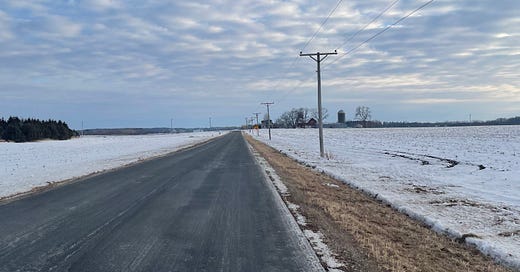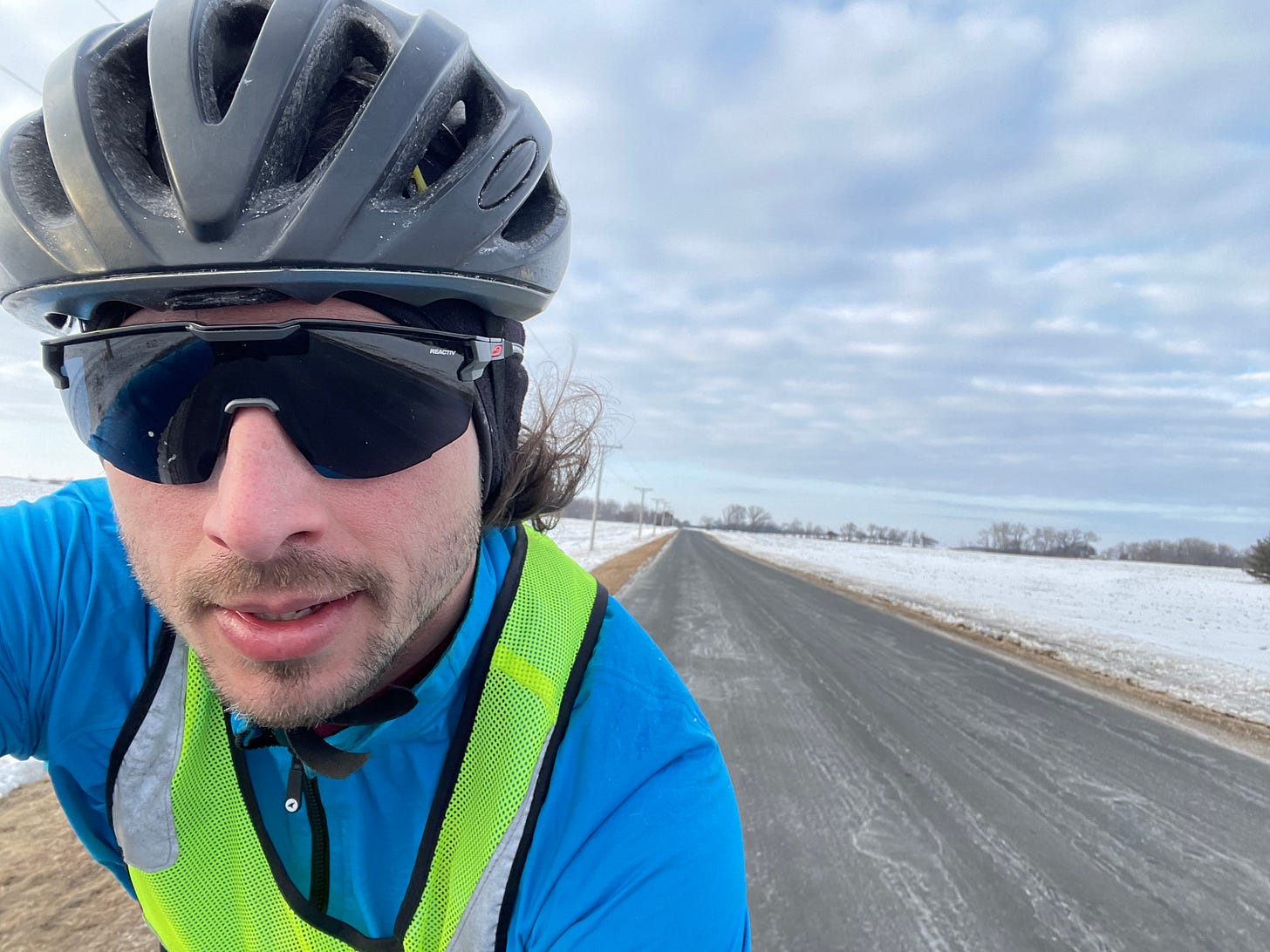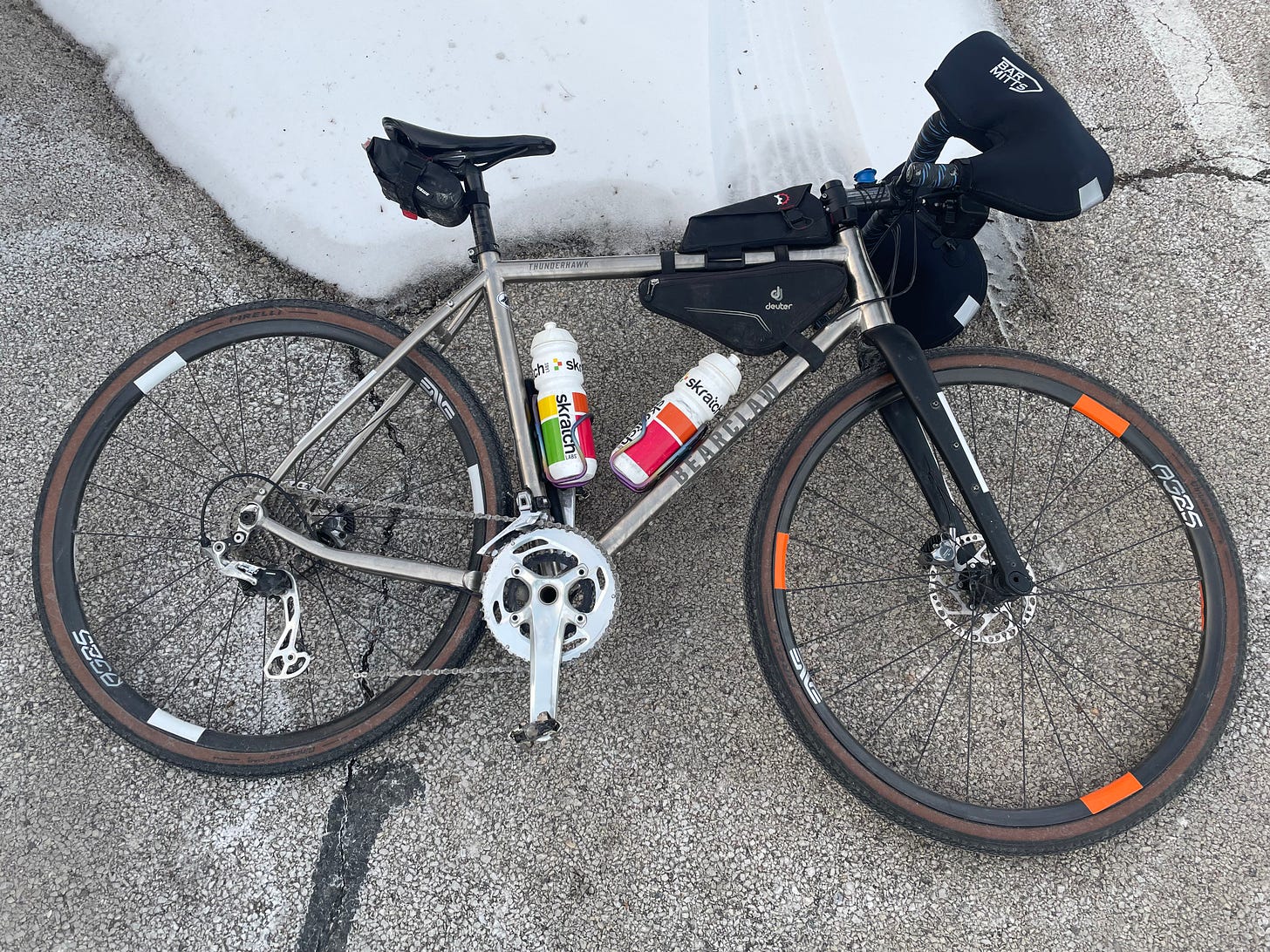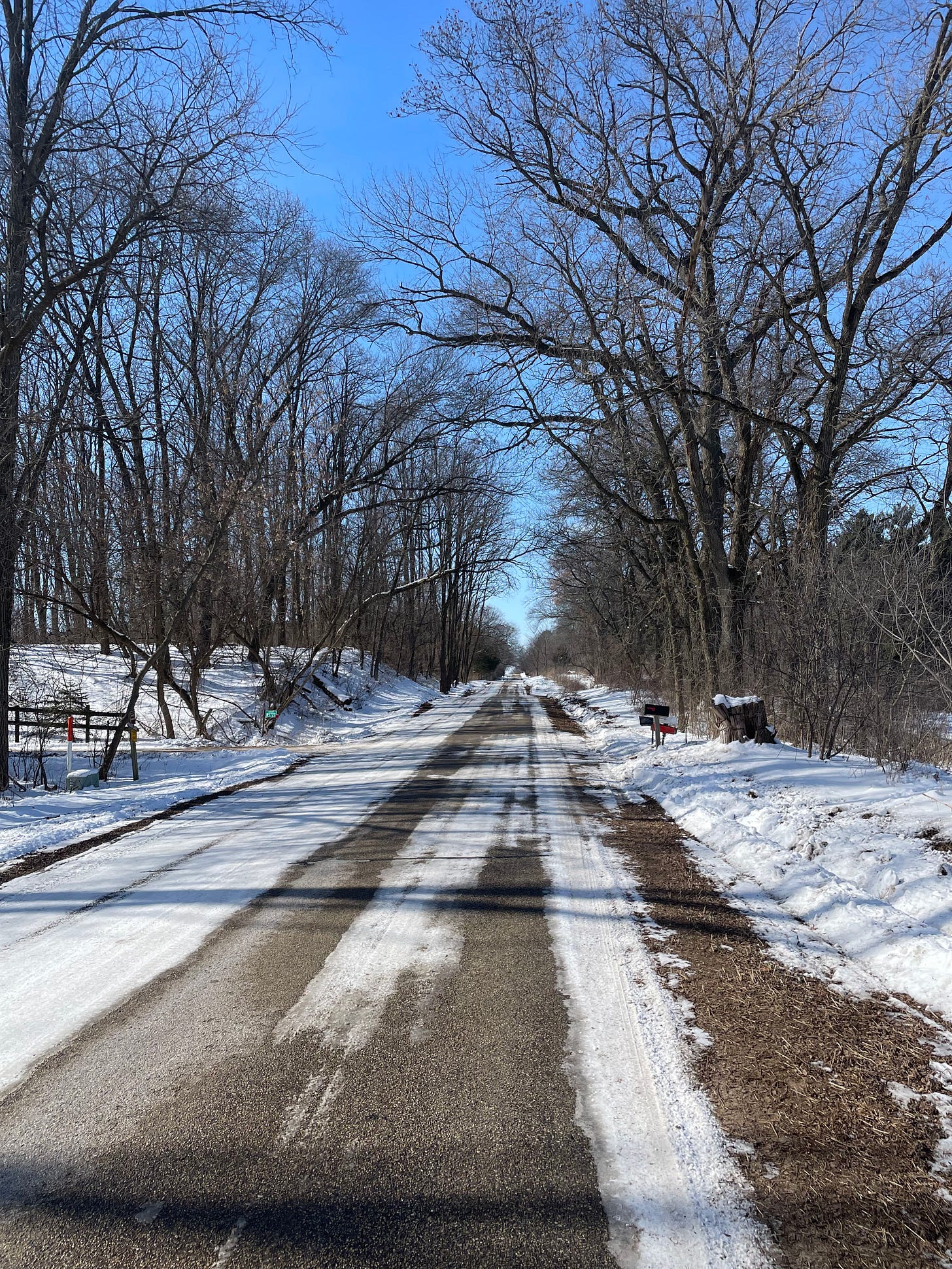Ride Report - Wuchak Sighting (RUSA Perm #5317)
It was quite cold and VERY windy, but it was also the last Saturday in February so the ride must go on!
The last ride report I wrote, I roughly divided the newsletter into “Route” and “Equipment” sections. That felt appropriate in the context of that ride, but I don’t intend for that to be a standard structure, if there ever is one to ride reports on this Substack.
That structure decidedly doesn’t work for this February R-12 ride. The weather, the route, the gear, other factors - it was all too intermingled. I even tried to segment it out at first, but it resulted in a weird mix that almost took the day in reverse.
So instead, I want to dive in a little more chronologically, taking the good and bad as it came during the ride. So.
Tim Doesn’t Do Freezing
I don’t ride in the cold. Almost ever. When it’s below 35 degrees Fahrenheit, my riding is usually limited to 1) the indoor trainer, or 2) 20 minute jaunts to and from a train while wearing a ski jacket.
But given that:
A) I didn’t want my 2025 R-12 attempt to falter in just the second month, and
B) This past weekend was the last one in the month,
I decided to accept “mostly sunny and about 15-30 degrees” this past Saturday as the best I was going to get.
All that moaning aside, I was quite well-prepared for the cold. Although my January R-12 ride was meaningfully warmer than this one, it gave me confidence in key pieces of gear like my Bar Mitts and my Under Armour/Long Sleeve Jersey/Windproof Rain Jacket layering strategy on my upper body.
I also pulled out a trick I’ve used before when the weather gets cold (although I didn’t use it in January) - a long pair of slider shorts/underwear underneath my bib tights. I know, I know, wearing underwear under bibs is a cardinal sin from aesthetic, comfort, AND hygiene perspectives. This is the exception.
Wearing these under my bibs gives me a second layer form waist to knees, right where you tend to catch a lot of cold air while riding a bike. And given that they’re a spandex-y synthetic material as well, they don’t interfere too much with the chamois. It’s more like having a second skin, and it’s surprisingly effective against the cold.
Once again, I did bring windproof pants with me as a safety net if the temperature really dropped, but once again I (thankfully) didn’t need them. Although it got close this time.
Can’t Stop, Won’t Stop
One of the things I want to practice this year is going further with fewer breaks along the way. This isn’t something I think is important for people who are just starting to stretch into longer distances (because fueling yourself is tough, and stops every few hours are a good reminder to eat something significant), but with my race and long randonneuring goals for the year, getting comfortable carrying enough food and water for 150-250 kilometers at a time is a skill I want to develop.
In the week leading up to this ride, I kept toying with the idea of trying to ride the course nonstop. As in no breaks for rest, no breaks for refueling - bring all the food and drink I need with me on the bike, and never stop moving. I couldn’t decide if that seemed like a good idea.
January had gone well! But it was going to be much colder. There was an easy stop right at halfway - maybe just take that distance stairstep and stop once? But I had a new hydration pack, so I could take plenty of food and liquid to go for the whole thing!
In the end, I decided the night before the ride that I was going to go for it. Since I was riding on my own, I didn’t have anyone else’s schedule to worry about - if I could keep rolling I would; if I ended up needing to stop, I could. No better time to try it.
Practice With Your Gear
It’s an axiom that any long distance cyclist should always heed: practice with your gear. As much as possible. Before you get into a high-consequence situation (really remote area, race context, etc.), you should be intimately familiar with your equipment and its limitations.
Because sometimes you don’t think about obvious things like the fact that liquids will freeze when it’s 15F outside.
By the 20 kilometer mark, the water in the hose of my hydration pack had frozen, as had my two 750ml bottles with carb/electrolyte mix, and I was physically prevented from intaking anymore of the 3.5 liters of liquids I’d started with.
Luckily, this was a solvable problem. I moved my hydration vest underneath my windproof jacket, and in the next hour and a half the ice had thawed enough that I could blow what remained backwards into the reservoir and start drinking again. I put off a similar strategy with my bottles initially, but by 50km I resigned myself to carrying them in my jersey’s back pockets (under my jacket) rather than on my bike frame. I won’t pretend that over three liters of water on my back was the most comfortable way to ride, but it got the job done.
This first section of the course - while I was dealing with all this - was thankfully pretty easy. There was a strong wind (around 15-30kph/10-20mph) all day out of the southwest, and I was almost exclusively pointed north for this stretch of the ride. Of course, the occasional short turn westward gave me an unpleasant taste of something I’d be dealing with most of the day.
It’s Windy, It’s Hilly, the Snow Sure Is Pretty
I chose this RUSA Permanent route for a couple key reasons.
First, it was very rural and featured no bike paths. The rural part pretty well speaks for itself - fighting through traffic is never fun, and it’s extra dangerous when road shoulders might be taken up by snow and ice. Getting way out on little two-lane back highways through farmland meant that I saw very few cars, and we were always able to give one another plenty of space.
But because these were still public roads, nearly everywhere was well-plowed and salted. Bike paths this time of year rarely get the same care, and often freeze into horrifically bumpy, slick passages that no one wants to ride without a fatbike.
On these country lanes, there were a few icy patches here and there, but the only time I failed to find any clear asphalt, the culprit was a strong wind picking up snow from the adjacent field and blowing it across the road. This created a sort of snow slushie where all these little snowflakes had been deposited and partially re-frozen together. Several roads along the route had been partially blown over in this manner, but there was only a single 50 meter stretch where I actually had to get off the bike and walk.
All told, this is a great course on some delightfully remote, low-traffic roads.
The second reason I chose this route was the elevation gain. In the greater Chicago area, there are only a few 200k routes that approach 1000m of elevation gain. I’ve now done the top two loops.
I’m not quite sure of the actual measurement because while the mapped route quotes 940m elevation gain, my Wahoo claimed just over 1500m at the end of the ride. I’m inclined to say that the map (and the above chart) is closer to accurate, but I certainly felt these hills more than I did on the Barrington route last month. I chose the hilly route because I very much want to be practicing climbing, but particularly through the middle third-ish of the route, the hills conspired with an increasing amount of time into headwind to make the whole thing feel like slow, hard work.
That wind really was a pain, though. Any time it was allowed to build over empty farmland it absolutely blasted me. This meant big sections of the ride where I was having to work to roll at 17-20kph. Obviously this has nothing to do with the course, just the weather the day I happened to ride it, but there was a noticeable difference even just in the wind break a stand of trees gave. Any time I got near a windbreak, my pace would rise into the 23kph range, even “into” the wind. But as soon as I passed, my pace would be pulled down again.
A smaller part of the perceived exertion also came from the fact that I wasn’t taking in quite as many calories per kilometer early in the ride as I’d originally planned. Since they had to thaw out, I didn’t have access to my bottles with carbohydrate mix for the first half of the ride. I still had plenty of bars and chews to eat, but keeping up with caloric demands during a long ride is a little trickier when you can’t drink a significant amount of carbs.
Some of this was my own decision. After tucking the bottles in under my jacket at the 50k mark, I elected to save them for the second half of the course so that they’d have plenty of time to thaw out before I tried to drink from them. The last thing I wanted to be doing was stopping every 10k to shuttle bottles in and out of my jersey.
It all worked out pretty well, actually. At 105k, I pulled out the first bottle and drank most of it within 30 minutes until the last quarter or so had refrozen into electrolyte slushie too thick to flow out. The other bottle came out around the 140km mark and stayed liquid until I was able to finish it. I drank the last of the water in my hydration pack just five kilometers from the finish.
Real-World Conditions Matter
This ride was also the first time I’ve gotten my bike outdoors since my latest bike fit, so adding onto the things I was trying to accomplish (R-12, climbing practice, nonstopping 200k…) was the first real-world test of my updated position.
Kind of like my solution to keeping my liquids liquid, it worked well enough but was certainly a little sub-optimal.
The good news is that my shoulders and neck also made it through the ride very well despite all the extra weight on my back.
The mixed news was that I was able to clearly identify a handful of issues that hadn’t fully become apparent while riding on the indoor trainer at the cost of some not-wholly-insignificant discomfort during the ride. That’s a bummer for a day, but it does mean I have a pretty clear course of action for my follow-up.
So: did I end up making the route non-stop?
Not quite. As I’ve already said, I had to stop to move my hydration vest and bottles under my jacket, and I did have to pause briefly each time I got a bottle back out. There were also a couple minutes in a post office lobby while I first got my hydration vest fully operational again.
But beyond that? I pretty much did it. Even with the normal, unavoidable short pauses for traffic lights and nature breaks, I was only paused for 21 minutes over the entire ride. I’d be lucky to replicate that just getting out of Chicago if I left straight from my house.
I was stopped enough that, for my own satisfaction, I can’t call it a nonstop ride, but I’m still proud of the outcome, especially considering the weather conditions.
Up Next
March is right around the corner, which means another R-12 ride will be coming soon enough. I’m still figuring out what that’s going to be, although I have my sights on a 300k out in Ohio as a possibility.
Not insignificantly, I figure I can’t have worse weather from March forward than I did for this ride. Snow covered fields are pretty, but I’m looking forward to some warm weather.
There’s also the start of the Chicago Randonneurs season! If you’re in the area, go sign up for RUSA and the Chi Rando club! It’s gonna be fun.
Lastly, if you aren’t yet subscribed to Roving Cyclist, consider taking the plunge! These newsletters will come right to your email inbox. There’s a lot of good stuff coming up very soon - more ride reports, some training advice, maybe some gear guides. Let me know what you want to hear about!










